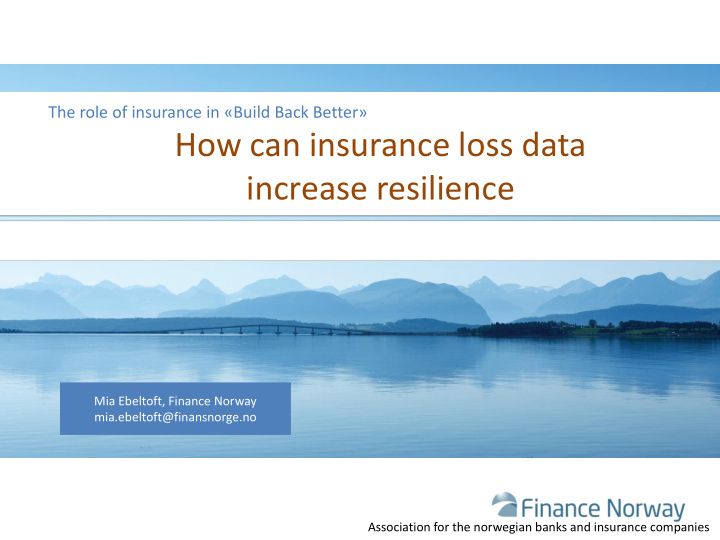



The role of insurance in «Build Back Better» How can insurance loss data increase resilience Mia Ebeltoft, Finance Norway mia.ebeltoft@finansnorge.no Association for the norwegian banks and insurance companies
“hits faster” “we need better statistics” (loss data) “engineers and political taskmasters do not embrace the scientist, but cling to old data, poor data or no data at all” 2
Norwegian insurance system I. Similar to France - NatCat = solidarity, flat premium II. Difference is urban flooding: - Does not consider that NatCat is risk based + strict liability for municipalities • Both covers are included in property insurance =100 % penetration • All municipalities (incl. industry + home owners) are covered by property insurance Property insurance Natcat coverage automatic included Fire (mandatory) under the “fire” insurance Theft Water& Urban flooding 3
Urban flooding cost more then all the natcat-losses Insurance pay outs 2008 - 2016 Landslide Storm surge Urban flooding (flash River flood) flooding NatCat vs Urban flooding 2008-2016 Cost pr mill NOK 3 000 2 500 Urban flooding 2 000 (sewer back up) 1 500 1 000 500 - 2008 2009 2010 2011 2012 2013 2014 2015 2016 4 Naturskader (NP) Vær-relaterte vannskader *)
Holistic risk picture: You need collaboration cross sectors Insurance Industry • Risk management Private Governments • Assessment Sector • Quantify & Calculate The value of • Risk transfer products collaboration • Collects local disaster loss Local data Public Agencies Authorities • Compensate, don’ t mitigate 5
Insurance loss data help authorities (mitigators) understand risk Source: IPCC 6
Best practice - examples: Three private – public projects supporting “Build Back Better” 7
Ex 1. Sharing local insurance loss data to strengthen resilience • Built on dialog and feed-back from municipalities • Stakeholders: – Finance Norway, ten pilot municipalities and researcher inst. + university • Reference group: national agencies. Metrological inst., Fed of municipalities • Project period: Sept 2013 to Feb 2015
Sharing local insurance loss data to strengthen resilience Main goals • Understand how local insurance loss data can help climate- resilient work • Strengthen municipalities’ knowledge base • Secure and preserve an insurance system – Avoid increasing number of damages – Avoid higher premiums, more differentiated premiums (urban flooding) – Avoid withdrawal from coverage / Preserve access to insurance
Risk and vulnerability: Oslo city’s own loss data 10
10 years of insurance loss data 11
Main conclusion The municipalities got: – New insights into risks previously unknown – Improved understanding • cost of claims • what is at risk and • Where the vulnerable areas are – This gives improved knowledge for • prioritizing management • maintenance & rehabilitation • reinvestment 12
From pilot to a permanent tool 14
15 Ex 2: Insurance loss adjusters collect Disaster Risk Management (DRM) Data for National agency for flood and landslide Valid for national risk understanding and DRM: 1. calibrate flood models 2. better prioritizing of local flood maps Building no. ID or type of building Water level cm +/- relative to ground floor level Basement? yes/no Erosion, under-mining of building? yes/no Mass deposition outside of the building? yes/no - thickness Damage due to floating objects etc. hitting the building? yes/no Supplementary information
Ex 3 Awareness of cost – payouts per municipality per year? http://www.climres.no/ http://setebos.svt.ntnu.no/climres/ 16
France = you can do the same! • The by far most usefull « tool » for local and national decision makers • Important exampels in the work of EU and international level (Sendai / SFDRR) • EU + EU Commission should - and are – share and promoting these good practices to all national markets 17
Recommend
More recommend